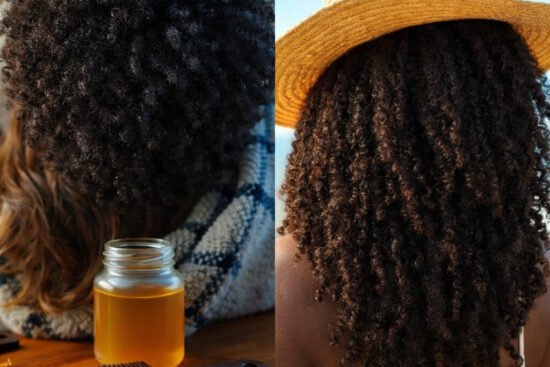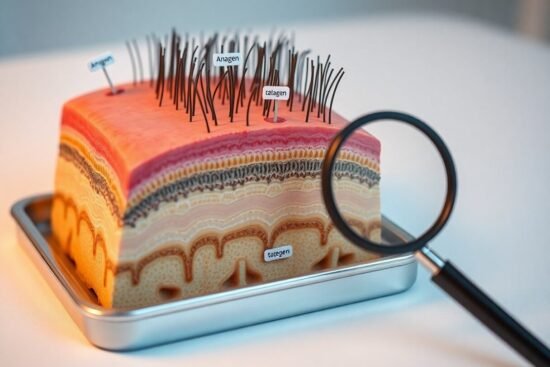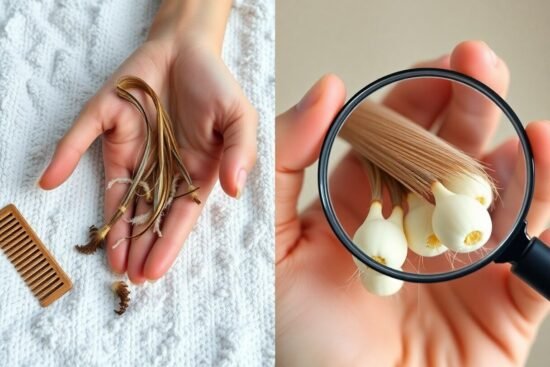
Just as you launch on your journey to embrace your natural hair, it’s necessary to understand the process that will help you navigate this transition smoothly. During this time, you may face challenges, but I assure you that with the right steps, you can successfully make the switch. You will learn how to identify your hair type, manage the two textures, and develop a detailed hair care routine that promotes healthy growth. Let’s explore the necessary steps and tips to achieve the vibrant, healthy natural hair you’ve always desired.

Key Takeaways:
- Understanding the difference between relaxed and natural hair is imperative in your transition journey.
- Gradually transitioning by allowing new growth while minimizing damage to relaxed ends is recommended.
- Consistent deep conditioning treatments can improve hair health and manageability during the transition.
- Finding the right styling techniques and products for your hair type can help maintain both textures while transitioning.
- Patience is key; the transition process can take time and may require different approaches for everyone.
- Support from online communities or friends who share similar experiences can greatly enhance your transition journey.
- Learning to embrace your natural texture can promote confidence and satisfaction throughout the process.
Unpacking the Transition: What You Need to Know
Understanding the transition from relaxed to natural hair involves more than just a change in products; it requires a comprehensive look at your hair’s characteristics and health. Successful transitioning depends on recognizing your unique needs and being prepared for the journey ahead. Once you understand your hair’s behavior, you can tailor your routine to enhance its natural beauty. This means shifting focus not only on style but also on care practices that promote growth and strength.
Understanding Hair Types and Textures
Identifying your specific hair type and texture is important for developing effective hair care strategies. There are several commonly recognized classifications, each with unique attributes:
- Type 1: Straight hair that tends to be shiny and smooth.
- Type 2: Wavy hair with a slight bend that adds volume.
- Type 3: Curly hair, adaptable to various styles, requiring careful moisture management.
- Type 4: Coily or kinky hair, known for its shrinkage and need for intensive hydration.
- This information will help you make informed choices about products and techniques that suit your unique hair structure.
| Hair Type | Characteristics |
| Type 1 | Straight, shiny, and fine |
| Type 2 | Wavy with volume and movement |
| Type 3 | Curls that can be loose or tight |
| Type 4 | Coils and kinks needing moisture |
Evaluating Your Current Hair Health
Assessing your hair’s health is a fundamental step in the transition process. You’ll want to examine factors such as breakage, split ends, and the overall texture. A thorough evaluation allows you to pinpoint areas needing improvement and adapt your routine accordingly.
To effectively evaluate your hair health, consider conducting a strand test. Gently pull a strand of hair; if it breaks easily, it indicates damage and needs extra TLC. Look for signs of dryness, as well; brittle strands often need deeper hydration. In addition, rely on moisture-retaining products like deep conditioners and leave-in treatments. Transitioning means you’ll be striving for balance—cherishing your new growth while nurturing the remaining relaxed ends. Strong, resilient hair plays a crucial role in achieving the look you desire.
Crafting Your Custom Care Plan
Developing a personalized care plan helps you manage your hair’s unique needs throughout the transitioning process. I recommend starting with an assessment of your hair type, texture, and porosity. This will guide your product selections and care practices. Incorporate deep conditioning treatments, regular trims, and protective styling into your plan to maintain health and beauty as your natural texture emerges. Adjustments will be necessary along the journey, as your hair will likely change as it grows, so be attentive and flexible in your approach.
Essential Products for Natural Hair
Choosing the right products is pivotal for embracing your natural texture. I lean towards moisturizing shampoos free from sulfates and hydrating conditioners to maintain moisture balance. Opt for a quality leave-in conditioner, a defining cream for curls, and oils like jojoba or argan to seal in moisture. When opting for products, watch out for silicones and parabens that can hinder hair growth and health. Explore different brands and find what resonates with your unique hair type for optimal results.
Developing a Consistent Routine
Establishing a routine helps your hair receive consistent care and promotes growth. I typically rotate through a regimen of cleansing, conditioning, and styling based on my hair’s needs. Cleansing might occur every week or bi-weekly, depending on your scalp’s oiliness or product buildup, while deep conditioning can happen weekly to foster moisture retention. Incorporate light protective styles and avoid excessive manipulation that can lead to breakage. By sticking to your schedule, you’ll encourage healthier hair while adjusting to this exciting transition.
Your routine should be a reflection of how your hair reacts over time. I suggest keeping a journal to document what works and what doesn’t. Track the frequency of washes, what products create the best results, and any changes you notice in your hair’s texture. This will not only help you stay organized but also ensure that your regimen evolves along with your hair. Over time, you’ll become familiar with its rhythms and needs, making it easier to adapt your routine as necessary.
The Big Chop: To Snip or Not to Snip
The decision to perform a big chop can be both exhilarating and intimidating. This ultimate transformation offers a fresh start for your natural hair journey, but it’s not a step to take lightly. Not only does it symbolize the end of your relaxed hair, but it also opens the door to fully embracing your natural texture. Some find liberation in starting anew, while others prefer a gradual transition. Whichever path you choose, I’ll guide you through this pivotal moment with confidence.
Assessing Your Readiness for a Big Change
Assessing your readiness for a big change involves both emotional and practical elements. Consider how you feel about cutting off the majority of your hair. Are you looking for a clean slate or simply frustrated with your relaxed ends? Think about your support system too—do your friends and family understand your journey? Engaging in self-reflection can ensure that the decision to chop is more about personal growth than external pressures.
Exploring Different Transitioning Methods
Exploring different transitioning methods allows you to find what best suits your lifestyle and comfort level. You can opt for the big chop and remove all relaxed ends in one go, or you could choose to transition gradually by growing out your natural hair while trimming relaxed ends over time. Additionally, there are protective styles, like braids or weaves, that can help shield your natural hair during the transition. Each method has its benefits and can be tailored to how quickly you want to embrace your natural journey.
For instance, the gradual method might appeal to those hesitant about drastic changes. This way, you can retain some length while slowly eliminating relaxed hair. I found this approach gave me the advantage of blending textures more smoothly and adapting to my natural curl pattern gradually. On the other hand, the big chop offers an immediate relief from the stress of maintaining two different textures. Think about your own hair goals and lifestyle, as every technique requires different levels of maintenance, commitment, and styling versatility. Make a choice that resonates with you and aligns with your vision for your natural hair journey.
Managing Expectations and Navigating Challenges
Embracing the transition from relaxed to natural hair often comes with unexpected challenges that can shake your confidence. Understand that this journey is unique for everyone and requires patience. I encountered moments of frustration, and it took time for me to appreciate and love my hair’s evolving texture. Set realistic goals for yourself, allowing for gradual adjustments and celebrating small victories along the way. The path may be bumpy, but having a clear vision of your desired outcome helps in managing those highs and lows.
Tackling Common Misconceptions About Natural Hair
Many misconceptions exist about natural hair, such as the belief that it’s unmanageable or excessively time-consuming. In my experience, while natural hair requires a different approach, it’s often more versatile than I initially thought. The potential for different hairstyles, from braids to curls, is enormous and allows for personal expression. Understanding the true nature of your hair can debunk these myths and empower you to embrace your unique beauty.
Coping with Hair Growth and Texture Changes
As your natural hair grows, expect noticeable changes in both length and texture, which can be thrilling yet overwhelming. I found that maintaining consistent hydration and moisture levels is necessary during this transformation. Initially, my hair texture shifted dramatically, leaving me unsure of how to style it. Keeping track of your hair health through a dedicated care routine can smooth out these transitions while allowing you to experiment with styles that enhance what you have.
Tracking hair growth can feel uneventful, but I discovered that measuring progress—like when my shrinkage became less pronounced—was immensely rewarding. Alongside regular trims and deep conditioning treatments, documenting your journey through photos or journal entries helps visualize subtle changes. Each phase of growth can bring about new challenges, whether working with coils, waves, or lengths you’re still adjusting to. Embrace every texture, and remember that every inch of growth represents a step towards embracing your natural self authentically.
Celebrating Your Natural Hair Journey
Each step of your natural hair journey deserves to be celebrated. From the moment you decide to transition to the first time you rock your natural curls in public, every milestone signifies personal growth and self-acceptance. Share your journey on social media, through blogs, or with friends, and embrace the uniqueness of your hair texture. Celebrate the new styles you create and the products you discover that work for you—it’s not just about hair; it’s about embracing who you are.
Finding Community and Support
Your transition can be vastly enriched by connecting with others who share similar experiences. Online forums, social media groups, and local meet-ups provide platforms to share advice, ask questions, and celebrate achievements in your natural hair journey. Engaging with a community can offer invaluable support, helping you stay motivated and inspired as you navigate the ups and downs of embracing your natural hair.
Embracing Different Styling Options
Exploring various styling options is one of the best parts of embracing your natural hair. From braids to buns, every technique not only showcases your personal style but also helps you learn more about your hair’s versatility. Play with protective styles like twists or faux locs to minimize manipulation and damage. Creating distinctive looks for different occasions empowers you to express yourself creatively while maintaining healthy hair. Experiment with accessories, colors, and textures to highlight your uniqueness and enjoy the process of styling your natural hair!
Final Words
As a reminder, transitioning from relaxed to natural hair requires patience and commitment. I hope this step-by-step guide has equipped you with the knowledge to navigate this journey confidently. Embrace the changes in your hair texture, and don’t hesitate to reach out for support or advice when needed. Your hair tells your story, and I’m excited for you to discover and celebrate your natural beauty through this process.
FAQ
Q: What does transitioning from relaxed to natural hair entail?
A: Transitioning from relaxed to natural hair involves gradually growing out your natural texture while simultaneously reducing the amount of relaxed hair. This process allows you to retain length while preparing your hair for eventual full-natural styling. It usually includes letting new growth come in while avoiding additional chemical treatments until all relaxed hair is trimmed away.
Q: How long does the transitioning process typically take?
A: The transitioning process can take anywhere from several months to a few years, depending on individual hair growth rates and how much relaxed hair one chooses to retain. Those with a plan to cut their relaxed ends may complete the process sooner, while others opting for a gradual approach may take longer.
Q: What are the best practices for maintaining hair health during the transition?
A: Ensuring the health of transitioning hair includes regular deep conditioning treatments, minimizing heat styling, and opting for protective hairstyles. Maintaining a balanced diet rich in vitamins and minerals, along with proper hydration, can also promote healthier hair growth throughout the transition.
Q: Should I cut my relaxed hair immediately or gradually during the transition?
A: The choice to cut relaxed hair immediately or gradually depends on individual comfort levels and hair goals. Some choose to do a big chop to remove all relaxed ends at once, while others prefer to gradually trim away relaxed hair over time to maintain length. Both methods can be effective; it comes down to personal preference.
Q: How often should I trim my hair during the transition?
A: Trimming frequency during the transition can vary, but it’s generally advisable to trim every 6-8 weeks to remove split ends and encourage healthier growth. The timing might also depend on the condition of your hair and how quickly you would like to remove the relaxed ends.
Q: What hairstyles are recommended for transitioning hair?
A: Recommended hairstyles for transitioning hair often include protective styles such as braids, twists, buns, and wigs, which can help reduce manipulation and damage. Low-maintenance styles are especially beneficial as they allow for minimal handling while transitioning between textures.
Q: Are there specific products I should use for transitioning hair?
A: Using products designed for hydration, such as leave-in conditioners, oils, and hydrating creams, can be beneficial for transitioning hair. Additionally, opt for sulfate-free shampoos and mild cleansers to avoid stripping moisture. Look for products with natural ingredients that cater specifically to curly or textured hair to enhance manageability and hydration during the transition.











